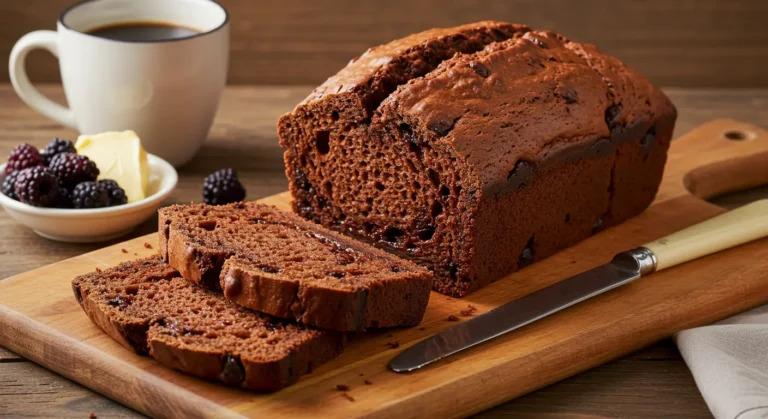How to Make a Chocolate Croissant Like a French Baker
Did you realize that the beloved chocolate croissant is actually misnamed in English? French bakers call these buttery, flaky treats “pain au chocolat” (chocolate bread) rather than “croissant au chocolat.” While traditional croissants are crescent-shaped, authentic pain au chocolat is rectangular with chocolate batons hidden inside. Mastering the art of making chocolate croissants at home might seem intimidating, but with proper technique and patience, you can create bakery-quality chocolate croissants that rival those found in Paris. The laminated dough process—creating dozens of alternating layers of butter and dough—is what gives chocolate croissants their characteristic flaky texture and buttery flavor.
Table of Contents
Ingredients List
For the chocolate croissant dough:
- 4 cups (500g) all-purpose flour
- 1/3 cup (67g) granulated sugar
- 2 teaspoons salt
- 1 tablespoon instant yeast
- 1 1/4 cups (300ml) cold milk
- 2 tablespoons (30g) unsalted butter, softened
For the butter layer:
- 1 1/2 cups (340g) high-quality European-style butter (at least 82% fat content)
- 2 tablespoons all-purpose flour
For the filling and finish:
- 8 ounces (230g) high-quality dark chocolate baking sticks or batons
- 1 egg, beaten with 1 tablespoon water for egg wash
- Optional: powdered sugar for dusting
Timing
- Preparation time: 45 minutes active work
- Resting/chilling time: 8-12 hours (ideally overnight)
- Folding and shaping: 1 hour
- Final proofing: 1-2 hours
- Baking time: 18-22 minutes
- Total time: Approximately 12 hours
Step-by-Step Instructions
Step 1: Prepare the Dough Base
Mix flour, sugar, salt, and yeast in a stand mixer with a dough hook. Add slightly warmed milk and softened butter gradually. Mix for 3 minutes until a cohesive dough forms, then knead for 5 minutes until smooth and elastic.
Pro tip: Avoid overworking the dough. It should pass the “windowpane test” where a small piece can be stretched thin enough to see light through without tearing.
Step 2: Initial Rest Period
Shape the dough into a 1-inch thick rectangle, wrap tightly in plastic, and refrigerate for at least 1 hour. This allows the gluten to relax and makes the dough more manageable for lamination.
Step 3: Prepare the Butter Layer
Place cold butter between parchment papers and beat with a rolling pin to soften slightly. Sprinkle 2 tablespoons of flour over the butter and incorporate it. Shape into an 8×8-inch square.
Step 4: Laminate the Dough
Roll chilled dough into a 12×16-inch rectangle. Position the butter square diagonally, then fold the corners of the dough over the butter like an envelope. Seal edges and gently tap the dough from center outward with your rolling pin.
Step 5: Create the First Set of Layers
Roll the dough into a 10×24-inch rectangle. Fold in thirds like a business letter to complete your first “turn.” Rotate 90 degrees, re-roll, and fold again for your second turn. Wrap and refrigerate for 1 hour.
Tip: If the butter feels soft or starts to ooze at any point, immediately return the dough to the refrigerator.
Step 6: Complete the Lamination
After chilling, repeat Step 5 twice more for a total of four turns. Wrap tightly and refrigerate for at least 4 hours, preferably overnight.
Step 7: Shape the Chocolate Croissants
Cut the dough in half and work with one piece at a time. Roll each piece into a 10×18-inch rectangle about 1/8 inch thick. Trim edges and cut into 6 equal pieces (4×6 inches each).
Place a chocolate baton along the short edge, roll over it once, add a second chocolate piece, and continue rolling. Place on parchment-lined baking sheets, seam side down, spaced 3 inches apart.
Step 8: Final Proofing
Cover shaped chocolate croissants loosely and let proof at room temperature for 1-2 hours until nearly doubled in size. Create an ideal proofing environment by placing them in an unheated oven with a pan of hot water on the bottom rack.
Step 9: Bake to Golden Perfection
Preheat oven to 400°F (200°C). Brush proofed croissants gently with egg wash and bake for 18-22 minutes, rotating halfway through, until deeply golden brown and reading 190°F (88°C) on an instant-read thermometer.
Nutritional Information
Per chocolate croissant (based on 12 servings):
- Calories: 420
- Total Fat: 26g (33% DV)
- Cholesterol: 75mg (25% DV)
- Sodium: 320mg (14% DV)
- Total Carbohydrates: 42g (15% DV)
- Protein: 6g (12% DV)
- Calcium: 40mg (3% DV)
- Iron: 2mg (11% DV)
Healthier Alternatives for the Recipe
Making chocolate croissants slightly healthier while maintaining their essential character is possible with these modifications:
- Whole Wheat Option: Replace up to 25% of the all-purpose flour with whole wheat pastry flour for added fiber and nutrients. Going higher than this ratio will compromise the delicate texture.
- Reduced Sugar: Decrease the sugar in the dough to 1/4 cup without significantly affecting texture. You can also try using coconut sugar for a lower glycemic index.
- Dark Chocolate Upgrade: Use 70-85% dark chocolate with less sugar and more antioxidants than semi-sweet or milk chocolate varieties.
- Portion Control: Make mini chocolate croissants by cutting the dough into smaller rectangles. This reduces the calorie count per serving while still providing the full flavor experience.
- Dairy Alternatives: While traditional butter is essential for authentic taste, you can substitute plant-based milk in the dough. However, for the butter layers, high-quality butter is necessary for proper lamination.
Serving Suggestions
Elevate your chocolate croissant experience with these serving ideas:
- Classic French Breakfast: Serve warm chocolate croissants alongside a café au lait or espresso, fresh seasonal fruit, and a small pot of good quality jam. This balanced approach provides a complete breakfast experience.
- Chocolate Croissant Bread Pudding: Transform day-old chocolate croissants into a luxurious dessert by cubing them and baking in a custard mixture with additional dark chocolate chunks and a splash of rum or orange liqueur.
- Savory Pairing: For a surprisingly delightful contrast, serve chocolate croissants with aged cheese like Comté or Gruyère. The salty-sweet combination is popular in many French households.
- Special Occasions: Create a chocolate croissant platter with various dipping options like fresh raspberry coulis, warm salted caramel sauce, or vanilla bean crème anglaise.
- On-the-Go Breakfast: Wrap freshly baked chocolate croissants in parchment paper and pair with fresh berries in a portable container for a decadent breakfast away from home.
Common Mistakes to Avoid
Even experienced bakers can struggle with chocolate croissants. Here are the pitfalls to watch for:
- Temperature Mismanagement: According to professional bakers, approximately 65% of laminated dough failures occur due to improper temperature control. Keep your butter cool but pliable—never melted or rock-hard.
- Uneven Rolling: Inconsistent thickness creates areas that bake at different rates. Use guide sticks (wooden dowels or rulers) alongside your dough when rolling to maintain even thickness.
- Overworking the Dough: Excessive kneading or rolling develops too much gluten, resulting in tough rather than tender chocolate croissants. Handle the dough gently and respect resting periods.
- Rushing the Process: Attempting to complete chocolate croissants in one day often leads to inferior results. The overnight rest is crucial for flavor development and proper structure.
- Improper Proofing: Underproofed chocolate croissants will be dense; overproofed ones collapse during baking. The finger test helps—when gently pressed, the dough should spring back slowly but not completely.
Storing Tips for the Recipe
Properly storing your chocolate croissants maintains their quality and extends their enjoyment:
- Same-Day Storage: Chocolate croissants are best enjoyed the day they’re baked, ideally within hours of coming out of the oven. Store at room temperature under a cake dome or loosely tented with foil to maintain crispness.
- Next-Day Revival: Day-old chocolate croissants can be refreshed by heating in a 300°F oven for 5-7 minutes. This restores some of the exterior crispness while warming the chocolate filling.
- Freezing Unbaked Croissants: For fresh-baked chocolate croissants anytime, freeze them after shaping but before proofing. Place on a baking sheet until solid, then transfer to airtight containers. When ready to bake, place on parchment-lined sheets, cover loosely, and let thaw/proof overnight in the refrigerator, then 1-2 hours at room temperature before baking.
- Freezing Baked Croissants: While not ideal, baked chocolate croissants can be frozen for up to 1 month. Wrap individually in plastic, then aluminum foil. Thaw at room temperature for 1 hour, then reheat at 325°F for 10 minutes.
- Dough Preparation: The laminated dough itself can be frozen after the final turn for up to 1 month. Thaw overnight in the refrigerator before rolling and shaping.
Conclusion
Creating authentic chocolate croissants at home is a rewarding culinary achievement that combines artisanal techniques with simple ingredients. The multi-day process rewards patience with incomparable flaky layers, buttery richness, and the perfect balance of chocolate. While time-intensive, the actual hands-on work is manageable, and the results elevate breakfast or brunch to a truly special occasion. Try this recipe to experience the satisfaction of crafting something extraordinary in your own kitchen.
Have you made these chocolate croissants? Share your experience in the comments section below! We’d love to see photos of your creations and hear about any variations you tried.
FAQs
Why did my chocolate croissants leak butter during baking? Butter leakage typically occurs when the dough gets too warm during preparation or the oven temperature isn’t hot enough at the start of baking. Ensure your dough stays cold throughout the lamination process and that your oven is properly preheated.
Can I make chocolate croissants with store-bought puff pastry? While technically possible, the result won’t be authentic. Croissant dough contains yeast and has a higher butter-to-flour ratio than puff pastry, creating a different texture and flavor. For the true French bakery experience, it’s worth making the dough from scratch.
My kitchen is warm. How can I keep the dough cold enough? If your kitchen exceeds 75°F (24°C), work in shorter intervals—15 minutes out of the refrigerator, then return for 15 minutes to chill. You can also chill your work surface by placing ice packs or frozen gel packs on it for several minutes before rolling the dough (wipe dry before using).
Your Feedback Matters
There are no reviews yet. Be the first one to write one.





